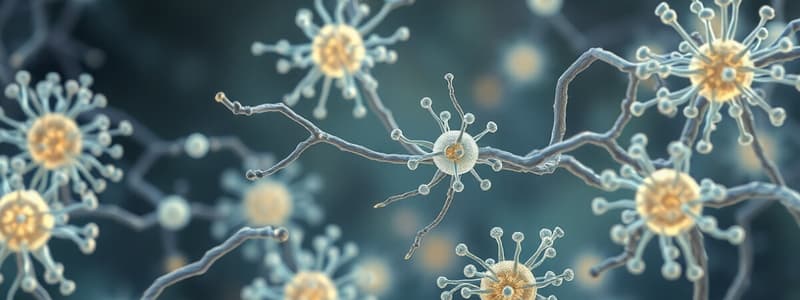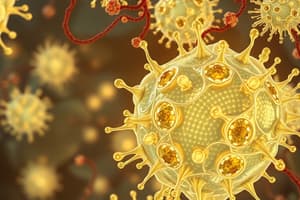Podcast
Questions and Answers
Which of the following best describes the function of sensory transduction?
Which of the following best describes the function of sensory transduction?
- Filtering out irrelevant sensory information.
- Converting the energy of a stimulus into an electrical signal. (correct)
- Amplifying the intensity of a stimulus.
- Storing sensory information for later recall.
What distinguishes a phasic receptor cell from a tonic receptor cell?
What distinguishes a phasic receptor cell from a tonic receptor cell?
- Phasic receptors signal changes in stimulus intensity, while tonic receptors provide sustained information. (correct)
- Phasic receptors respond slowly and tonics respond rapidly.
- Phasic receptors adapt very slowly, while tonic receptors adapt quickly.
- Phasic receptors are used for detecting light and color, while tonic receptors are used for mechanical stimuli.
Which of the following is NOT a method of classifying sensory receptor cells?
Which of the following is NOT a method of classifying sensory receptor cells?
- How they transduce sensory stimuli into electrical stimuli
- Rate of adaptation (correct)
- Stimulus energy that excites the cells
- Sensory modality
What is the primary difference between ionotropic and metabotropic transduction?
What is the primary difference between ionotropic and metabotropic transduction?
Which of the following is an example of an interoceptor?
Which of the following is an example of an interoceptor?
In the context of sensory systems, what is the 'labeled-lines principle'?
In the context of sensory systems, what is the 'labeled-lines principle'?
What is the function of stretch-activated ion channels in insect sensilla?
What is the function of stretch-activated ion channels in insect sensilla?
Which of the following touch receptors is primarily responsible for sensing fine texture and edges?
Which of the following touch receptors is primarily responsible for sensing fine texture and edges?
What is a defining characteristic of Pacinian corpuscles that contributes to their extremely phasic response?
What is a defining characteristic of Pacinian corpuscles that contributes to their extremely phasic response?
How do noctuid moths utilize their tympanic membranes for survival?
How do noctuid moths utilize their tympanic membranes for survival?
In vertebrates, what is the role of hair cells in hearing?
In vertebrates, what is the role of hair cells in hearing?
Which ossicle(s) is/are found only in the mammalian middle ear?
Which ossicle(s) is/are found only in the mammalian middle ear?
How do high-frequency sounds differ from low-frequency sounds in terms of their effect on the cochlea?
How do high-frequency sounds differ from low-frequency sounds in terms of their effect on the cochlea?
What is the role of the organ of Corti in the inner ear?
What is the role of the organ of Corti in the inner ear?
How do semicircular canals contribute to the sense of balance?
How do semicircular canals contribute to the sense of balance?
What triggers the release of neurotransmitters from hair cells in the semicircular canals?
What triggers the release of neurotransmitters from hair cells in the semicircular canals?
Which of the following statements accurately describes sensory adaptation?
Which of the following statements accurately describes sensory adaptation?
If a toxin were to selectively damage metabotropic receptors, which sensory process would be MOST directly affected?
If a toxin were to selectively damage metabotropic receptors, which sensory process would be MOST directly affected?
How does the arrangement of sterocilia (microvilli) on hair cells contribute to the detection of sound?
How does the arrangement of sterocilia (microvilli) on hair cells contribute to the detection of sound?
What is the functional significance of the fact that sensory cells detecting sound and taste do not have axons that enter the CNS?
What is the functional significance of the fact that sensory cells detecting sound and taste do not have axons that enter the CNS?
Flashcards
Sense organs
Sense organs
Anatomical structures specialized for receiving particular kinds of stimuli.
Sensory transduction
Sensory transduction
Turning stimulus energy into an electrical signal.
Sensory adaptation
Sensory adaptation
The frequency of action potentials decreases over time with continuous stimulation.
Phasic receptor cell
Phasic receptor cell
Signup and view all the flashcards
Tonic receptor cell
Tonic receptor cell
Signup and view all the flashcards
Sensory modality
Sensory modality
Signup and view all the flashcards
Exteroceptors
Exteroceptors
Signup and view all the flashcards
Interoceptors
Interoceptors
Signup and view all the flashcards
Mechanoreceptors
Mechanoreceptors
Signup and view all the flashcards
Sensillum
Sensillum
Signup and view all the flashcards
Dorsal root ganglion
Dorsal root ganglion
Signup and view all the flashcards
Merkel disc
Merkel disc
Signup and view all the flashcards
Meissner corpuscles
Meissner corpuscles
Signup and view all the flashcards
Ruffini endings
Ruffini endings
Signup and view all the flashcards
Pacinian corpuscles
Pacinian corpuscles
Signup and view all the flashcards
Hair cells
Hair cells
Signup and view all the flashcards
Cochlea
Cochlea
Signup and view all the flashcards
Semicircular canals
Semicircular canals
Signup and view all the flashcards
Tympanal membrane
Tympanal membrane
Signup and view all the flashcards
Study Notes
- Sense organs are specialized anatomical structures that receive particular kinds of stimuli.
- Receptor cells within sense organs contain membrane-bound proteins that receive specific stimuli.
- Sensory transduction is the process of turning stimulus energy into an electrical signal.
- Sensory cells can produce their own action potential or excite a nearby neuron using neurotransmitters.
- Sensory adaptation is the decrease in the frequency of action potentials in response to continuous, constant stimulation over time.
Phasic Receptor Cells
- Phasic receptor cells respond rapidly to a stimulus.
- Their response to a maintained stimulus decreases rapidly and stops, even if the stimulus is still present.
- They are good at signaling changes in stimulus.
Tonic Receptor Cells
- Tonic receptor cells respond slowly to a stimulus.
- Their response to a maintained stimulus decreases slowly and incompletely until the stimulus stops.
Classifying Sensory Receptor Cells by Sensory Modality
- Classical senses include hearing, taste, touch, smell, and vision.
- Some animals sense balance, temperature, pain, electrical fields, and magnetic fields, not limited to the five classical senses.
Classifying Sensory Receptor Cells by Stimulus Energy
- Sensory receptor cells respond to electromagnetic energy (light, electrical fields, magnetic fields).
- Sensory receptor cells respond to mechanical energy (sound, touch, balance).
- Sensory receptor cells respond to chemical energy (smell, taste).
Classifying Sensory Receptor Cells by Electrical Stimuli Transduction
- Ionotropic transduction occurs when the receptor molecule is an ion channel.
- The receptor molecule receives the signal and transduces it by changing the cell membrane's permeability to ions.
- Metabotropic transduction occurs when signal receptors receive the signal and activate intracellular signaling cascades via G protein-coupled receptors.
Classifying Sensory Receptor Cells by Location
- Exteroceptors respond to stimuli outside the body.
- Interoceptors respond to internal stimuli.
- Sensory cells can be separated by sensory modalities with focus on hearing, taste, touch, smell, and vision.
- Sensory receptor cells for touch and smell are neurons with axons that enter the CNS.
- Sensory receptors for light are specialized neurons that synapse on other neurons outside of the CNS.
- Sensory cells that detect sound and taste have no axons, but synaptically excite sensory neurons by releasing neurotransmitters.
- Insects, fish, and mammals have well understood sensory receptors.
- The central nervous system receives signals from sensory cells and integrates that input.
- Signals are received by particular parts of the brain from different types of sensory neurons.
Mechanoreceptors in Touch
- Mechanoreceptors are specialized cells that respond to mechanical stimuli, like touch and sound.
- Sensillum are sense organs found in insects.
- Many sensillum are mechanoreceptors (some are chemosensory).
- Bristle of sensillum is part of exoskeleton.
- Dendrites of the mechanoreceptor cell are attached to the inside of the bristle shaft at its base.
- Movement of the bristle opens stretch-activated ion channels in the dendrites, causing a depolarization of the cell and starting an action potential.
- The stronger the stimulus, the more action potentials.
- In mammals, the skin is the main sensory organ for touch.
- Dorsal root ganglion contains sensory neurons with cell bodies in the dorsal root ganglia adjacent to the spinal cord.
- They have stretch-activated ion channels (Piezo channels).
- These cells have four types of touch-sensitive endings in the skin.
Merkel Disc
- Formed by the association of a Merkel cell with a branched nerve ending.
- senses texture, shape, edges.
- Tonic receptors.
Meissner Corpuscles
- Has two to six sensory neuron endings.
- Touch sensitive.
- Phasic receptors
Ruffini Endings
- Pressure Sensitive
- Tonic receptors
Pacinian Corpuscles
- Located deep in the skin.
- Senses only vibration.
- This has an extremely phasic response, and only responds to rapid changes in mechanical pressure.
- This is encased in lamellae.
Hearing
- Animals use mechanoreceptors to sense sound with sound waves consisting of compression of air or water.
- Insects have a tympanal membrane that is displaced by sound waves.
- Mechanosensory cells are attached to the tympanum and are stimulated by its movement.
- Sensory organs evolved repeatedly in different groups of insects.
- Tympanal organs may occur at any of several locations on an insect’s body.
- Noctuid moths have a tympanic membrane that mainly sense ultrasonic frequencies (>20,000 Hz).
- Moths are preyed upon by echolocating bats, which produce ultrasonic cries.
- Have paired thoracic tympanic membranes each connected to a single sensory neuron.
- Vertebrates use hair cells to detect sound.
- Hair cells are epithelial cells with microvilli (sterocilia) arranged in a line from shortest to longest.
- Hair cells release neurotransmitter onto neurons, which conduct action potentials to the CNS.
- As microvilli are pushed further toward the longest microvillus, more neurotransmitter is released.
- Tetrapod ears have an external, middle, and inner ear.
- The external ear helps collect sound waves.
- The external ear consists of the pinna (not found in all vertebrates) and ear canal.
- The middle ear uses ossicles to transmit sound vibrations from the eardrum to the inner ear via the oval window.
- Ossicles include the malleus, incus, and stapes in mammals.
- Only the stapes are in reptiles, birds, and amphibians.
- The inner ear has a cochlea, a coiled tube containing fluid and hair cells in the organ of Corti.
- Hair cells sit on top of the basilar membrane, which separates the cochlea into upper and lower chambers.
- The oval window transmits sound, causing the basilar membrane to move, which pushes hair cells against the tectorial membrane causing hair cells to release neurotransmitters on neurons.
- High frequency sounds vibrate the stiffer and narrower beginning of the cochlea; low frequency sounds vibrate the wider end.
- The semicircular canals of the ears also help with balance.
- There are three semicircular canals that are arranged at roughly at right angles to each other.
- The superior duct allows forward and backward motion.
- The posterior duct allows shoulder to shoulder motion.
- The lateral duct allows left to right motion.
- Fluid-filled Canals detect angular movement in all directions in a region called the ampulla.
- Head movement causes fluid and microvilli on hair cells to move.
- Moving microvilli on hair cells causes the hair cells to release neurotransmitters.
- All jawed vertebrates have semicircular canals.
Studying That Suits You
Use AI to generate personalized quizzes and flashcards to suit your learning preferences.



